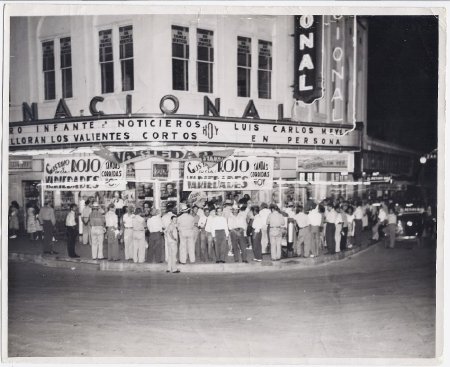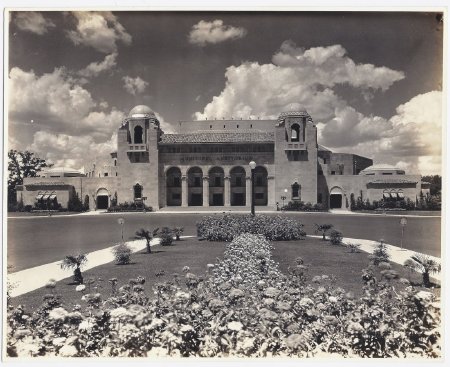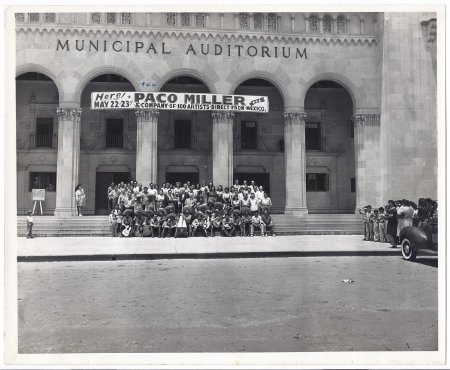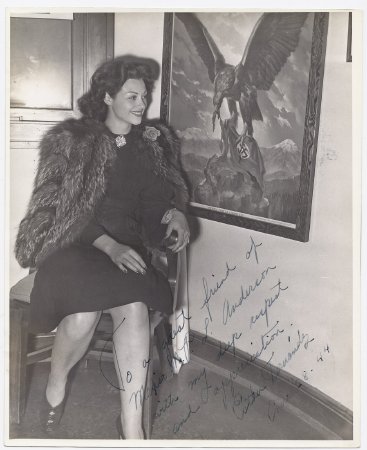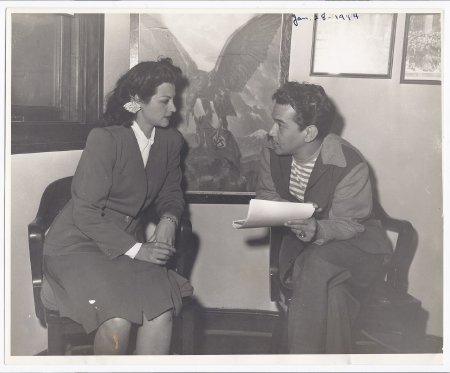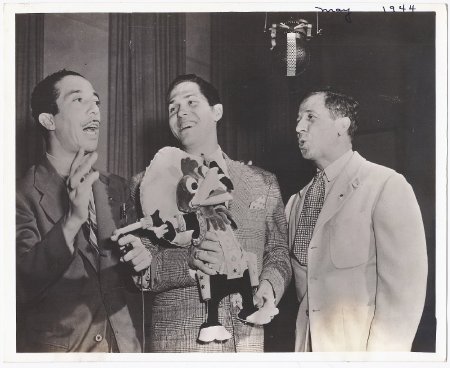Latino/a Stars & Raul Cortez
History:
Even in the midst of war people craved entertainment. Throughout the 1940s, San Antonio's Latino community experienced a variety of new opportunities to enjoy top-notch Spanish-language movies, music and variety shows. On the Westside, Gaetano Lucchese remodeled the Teatro Nacional (1939) and opened the Guadalupe Theater (1942), drawing crowds with major motion pictures that would come to define the "Golden Age of Mexican Cinema." Meanwhile, impressarios (booking agents) Raul and Ramiro Cortez brought famous film, music, and radio stars from Mexico and Latin America to Municipal Auditorium for a variety of popular civic events, performances, and fundraisers. These events often featured military themes and included wartime appeals to donate blood or to buy war-bonds.
1944 became a star-studded year for San Antonio. January saw the arrival of several Latino/a singers and film stars, including Esther Fernandez, Paquita Estrada, Joaquin Pardave, Hermanos Huesca, and Cantinflas (Mario Moreno), who came to help Ramiro and Raul Cortez celebrate the 9th anniversary of their popular radio program, "La Hora Comercial Mexicana."33 Despite the fact that foreign language radio was monitored and severely limited during the war, Raul Cortez applied to establish his own English-Spanish radio station, KCOR, in 1944. He argued that he could use his station to help drum up support for the war effort, but it was not until 1946 that he finally received approval. When KCOR hit the airwaves, it became the first radio station in the U.S. owned and operated by a Latino.34
1944 became a star-studded year for San Antonio. January saw the arrival of several Latino/a singers and film stars, including Esther Fernandez, Paquita Estrada, Joaquin Pardave, Hermanos Huesca, and Cantinflas (Mario Moreno), who came to help Ramiro and Raul Cortez celebrate the 9th anniversary of their popular radio program, "La Hora Comercial Mexicana."33 Despite the fact that foreign language radio was monitored and severely limited during the war, Raul Cortez applied to establish his own English-Spanish radio station, KCOR, in 1944. He argued that he could use his station to help drum up support for the war effort, but it was not until 1946 that he finally received approval. When KCOR hit the airwaves, it became the first radio station in the U.S. owned and operated by a Latino.34
About this Image:
1) Marquee of the Teatro Nacional, located at the corner of W. Commerce and Santa Rosa, advertising a Pedro Infante film. Credit: Ignacio Torres.
2) Architects Atlee B. and Robert M. Ayres, George Willis, and Emmett Jackson designed San Antonio's Spanish Colonial Revival style auditorium, which was dedicated in 1926 as a memorial to WW I veterans. This photo features a view of the front (south) façade of the auditorium, which hosted a variety of large scale events for the Latino community. Photographer: Harvey Patteson.
3) A group photograph of cast of the Paco Miller Vaudeville Show taken in front of Municipal Auditorium. The various band members seated in front are already in costume. Several onlookers and children stand on the right side of the steps.
4) In his role as acting mayor in 1944, P.L. Anderson frequently met with visiting officials and entertainers. Esther Fernandez, a Mexican movie star, wears a fur coat while seated in Commissioner Anderson's office at City Hall. Behind her is a war propaganda poster titled, "Mexico por la libertad." by Jose Bribiesca.
5) Movie stars Esther Fernandez (left) and Mario Moreno Reyes (Cantinflas) (right) sit in the office of Commissioner P.L. Anderson in City Hall during their January visit.
6) The role of foreign language radio grew in the forties. Prior to Raul Cortez's establishment of KCOR, he bought time slots on other radio stations to host his show, "La hora Commercial Mexicana," as well as to promote various performers. In this photo, three singers stand beneath a studio microphone. Paco Miller, center, holds a stuffed toy rooster representing Panchito Pistoles from Disney's 1945 animated film, "The Three Caballeros."
2) Architects Atlee B. and Robert M. Ayres, George Willis, and Emmett Jackson designed San Antonio's Spanish Colonial Revival style auditorium, which was dedicated in 1926 as a memorial to WW I veterans. This photo features a view of the front (south) façade of the auditorium, which hosted a variety of large scale events for the Latino community. Photographer: Harvey Patteson.
3) A group photograph of cast of the Paco Miller Vaudeville Show taken in front of Municipal Auditorium. The various band members seated in front are already in costume. Several onlookers and children stand on the right side of the steps.
4) In his role as acting mayor in 1944, P.L. Anderson frequently met with visiting officials and entertainers. Esther Fernandez, a Mexican movie star, wears a fur coat while seated in Commissioner Anderson's office at City Hall. Behind her is a war propaganda poster titled, "Mexico por la libertad." by Jose Bribiesca.
5) Movie stars Esther Fernandez (left) and Mario Moreno Reyes (Cantinflas) (right) sit in the office of Commissioner P.L. Anderson in City Hall during their January visit.
6) The role of foreign language radio grew in the forties. Prior to Raul Cortez's establishment of KCOR, he bought time slots on other radio stations to host his show, "La hora Commercial Mexicana," as well as to promote various performers. In this photo, three singers stand beneath a studio microphone. Paco Miller, center, holds a stuffed toy rooster representing Panchito Pistoles from Disney's 1945 animated film, "The Three Caballeros."
To Learn More:
View Catalog Record (Image 3)
View Catalog Record (Image 4)
View Catalog Record (Image 5)
View Catalog Record (Image 6)
American History Cortez & KCOR
Raul Cortez History
View Catalog Record (Image 4)
View Catalog Record (Image 5)
View Catalog Record (Image 6)
American History Cortez & KCOR
Raul Cortez History
Credit:
Courtesy of San Antonio Conservation Society Foundation.

